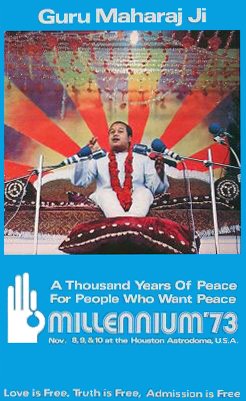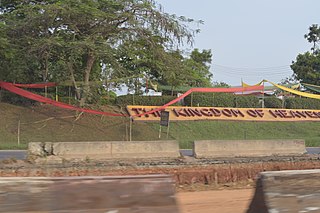Knowledge is a term used by Shri Hans Ji Maharaj to denote a formulation of four specific techniques that were imparted in a process of initiation. The term continues to be used by two of Shri Hans Ji Maharaj's sons, Satpal Rawat and Prem Rawat.

Prem Pal Singh Rawat, formerly known as Maharaji, is an Indian international speaker and author. His teachings include a meditation practice he calls "Knowledge", and peace education based on the discovery of personal resources such as inner strength, choice, appreciation and hope.
Hans Rām Singh Rawat, called Shrī Hans Jī Mahārāj and by various other honorifics, was an Indian religious leader.
The Divine Light Mission was an organization founded in 1960 by guru Hans Ji Maharaj for his following in northern India. During the 1970s, the DLM gained prominence in the West under the leadership of his fourth and youngest son. Some scholars noted the influence of the Bhagavad Gita and the Radha Soami tradition, a.k.a. Sant Mat movement, but the western movement was widely seen as a new religious movement, a cult, a charismatic religious sect or an alternative religion. DLM officials said the movement represented a church rather than a religion.
Maharaj Ji, Maharaji, or similar, may refer to:
Surat Shabd Simran is a type of spiritual meditation in the Sant Mat tradition.
The core of Prem Rawat's teaching is that the individual’s need for fulfillment can be satisfied by turning within to contact a constant source of peace and joy. Rather than a body of dogma, he emphasizes a direct experience of transcendence, which he claims is accessible through the four techniques of meditation which he teaches. He calls these techniques "Knowledge" and says that Knowledge will take "all your senses that have been going outside all your life, turn them around and put them inside to feel and to actually experience you."

Radha Soami is a spiritual tradition or faith founded by Shiv Dayal Singh in 1861 on Basant Panchami Day in Agra, India.

Lord of the Universe is a 1974 American documentary film about Prem Rawat at an event in November 1973 at the Houston Astrodome called "Millennium '73". Lord of the Universe was first broadcast on PBS on February 2, 1974, and released in VHS format on November 1, 1991. The documentary chronicles Maharaj Ji, his followers and anti-Vietnam War activist Rennie Davis who was a spokesperson of the Divine Light Mission at the time. A counterpoint is presented by Davis' Chicago Seven co-defendant Abbie Hoffman, who appears as a commentator. It includes interviews with several individuals, including followers, ex-followers, a mahatma, a born-again Christian, and a follower of Hare Krishna.
This list is of topics related to Prem Rawat (Maharaji).

Who is Guru Maharaj Ji?, published in 1973 by Bantam Books is a non-fiction book about Guru Maharaj Ji, now known as Prem Rawat. Edited by Charles Cameron, the book claims to be an "authentic authorized story", and was written when Maharaj Ji was aged 15. The initial printing was of 125,000 copies. A Spanish-language edition was also published in 1975, as Quién es Guru Maharaj Ji.

Millennium '73 was a three-day festival held on November 8–10, 1973 at the Astrodome in Houston, Texas, United States, by the Divine Light Mission (DLM). It featured Prem Rawat, then known as Guru Maharaj Ji, a 15-year-old guru and the leader of a fast-growing new religious movement. Organizers billed the festival as the most significant event in human history which would usher in a thousand years of peace.
Bibliography of Prem Rawat and related organizations lists bibliographical material regarding Prem Rawat and organizations like Divine Light Mission, Elan Vital and the Prem Rawat Foundation.

Salig Ram, successor of Shiv Dayal Singh second Sant Satguru of the Radhasoami Satsang popularly known by the honorific "Huzur Maharaj" and by the government-conferred title "Rai Bahadur," was born in Peepal Mandi, Agra, on 14 March 1829. He served as chief inspector of post offices in British India, and, in 1881, was Postmaster-General of the North-Western Provinces, based in Allahabad. He was the first Indian to hold the position.

Satpal Maharaj is an Indian spiritual guru turned politician. He is a national executive member of the BJP. Currently, he serves as the tourism, cultural, and irrigation minister in the cabinet of the Government of Uttarakhand. He is the founder of Manav Utthan Sewa Samiti.

Jagadguru Shri Kripalu Ji Maharaj was an Indian spiritual guru and the fifth Jagadguru. He was the founder of Prem Mandir in Vrindavan, one of the ten largest Hindu temples in the world. He was also the founder of Jagadguru Kripalu Parishat (JKP), a worldwide Hindu non-profit organization with five main ashrams, four in India and one in the United States.

Guru Maharaj Ji, born Mohammed Ajirobatan Ibrahim on December 20, 1947, is a Nigerian spiritual leader. He lives in Ibadan. He has declared himself to be a Living Perfect Master, Guru Maharaj Ji, and is also called the "Black Jesus". He says that he has power over all illnesses and all problems affecting humanity.
This is a list of gurus who gave teachings about Shabda, the Path of Sound.
Rawat is a surname of people belonging to Hindu Rajput community. It is used as a surname, but during the medieval period it was a designation or title given to a soldier who performed exceptionally well in war. Types of Rawat are Chauhan Rawat, Pawar Rawat, Sisodiya Rawat, Dogra Rawat, Rawat Meena etc. from Uttarakhand and U.P divisions in the Indian state of Uttarakhand and Rajputs of Uttarakhand.








